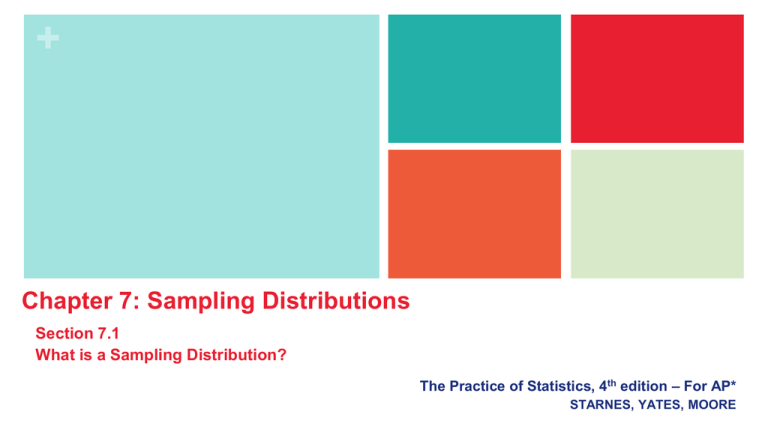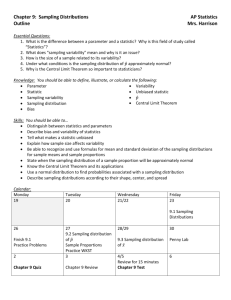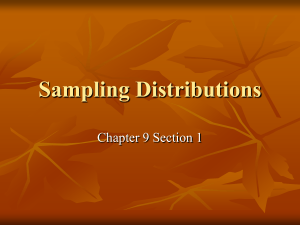+ Sampling Distribution
advertisement

+ Chapter 7: Sampling Distributions Section 7.1 What is a Sampling Distribution? The Practice of Statistics, 4th edition – For AP* STARNES, YATES, MOORE + Chapter 7 Sampling Distributions ■ 7.1 What is a Sampling Distribution? ■ 7.2 Sample Proportions ■ 7.3 Sample Means + Section 7.1 What Is a Sampling Distribution? Learning Objectives After this section, you should be able to… ✓ DISTINGUISH between a parameter and a statistic ✓ DEFINE sampling distribution ✓ DISTINGUISH between population distribution, sampling distribution, and the distribution of sample data ✓ DETERMINE whether a statistic is an unbiased estimator of a population parameter ✓ DESCRIBE the relationship between sample size and the variability of an estimator + Introduction Sample Collect data from a representative Sample... Make an Inference about the Population. What Is a Sampling Distribution? Population A parameter is a number that describes some characteristic of the population. In statistical practice, the value of a parameter is usually not known because we cannot examine the entire population. A statistic is a number that describes some characteristic of a sample. The value of a statistic can be computed directly from the sample data. We often use a statistic to estimate an unknown parameter. Remember s and p: statistics come from samples and parameters come from populations NOTATION!! What Is a Sampling Distribution? Definition: + Parameters and Statistics + Identify the population, parameter, sample, and statistic ■ The Gallup Poll asked a random sample of 515 US adults whether or not they believe in ghosts. Of the respondents, 160 said “yes.” ■ During the winter months, the temperatures outside the Starnses’ cabin in Colorado can stay well below freezing for weeks at a time. To prevent the pipes from freezing, Mrs. Starnes sets the thermostat at 50F. She wants to know how low the temperature actually gets in the cabin in the month of January. A digital thermometer records the indoor temperature at 20 randomly chosen times during the month. The minimum reading is 38F. + Parameter or Statistic? What’s the correct notation? ■ On Tuesday, the bottles of Arizona Iced Tea filled in a plant were supposed to contain an average of 20 ounces of iced tea. Quality control inspectors sample 50 bottles at random from the day’s production. These bottles contained an average of 19.6 ounces of iced tea. ■ On a New York to Denver flight, 8% of the 125 passengers were selected for random security screening before boarding. According to the TSA, 10% of passengers at this airport are chosen for random screening. + Sampling Variability To make sense of sampling variability, we ask, “What would happen if we took many samples?” Sample Population Sample Sample Sample Sample Sample Sample Sample ? What Is a Sampling Distribution? This basic fact is called sampling variability: the value of a statistic varies in repeated random sampling. Reaching for Chips What Is a Sampling Distribution? Reaching for Chips What Is a Sampling Distribution? Students took a sample of 20 poker chips from a bag of red and blue chips, recorded the sample proportion of red chips, and returned all chips to the bag. Definition: The sampling distribution of a statistic is the distribution of values taken by the statistic in all possible samples of the same size from the same population. NOTE: In practice, it’s difficult to take all possible samples of size n to obtain the actual sampling distribution of a statistic. Instead, we can use simulation to imitate the process of taking many, many samples. One of the uses of probability theory in statistics is to obtain sampling distributions without simulation. We’ll get to the theory later. What Is a Sampling Distribution? In the previous activity, we took a handful of different samples of 20 chips. There are many, many possible SRSs of size 20 from a population of size 200. If we took every one of those possible samples, calculated the sample proportion for each, and graphed all of those values, we’d have a sampling distribution. + Sampling Distribution 1) The population distribution gives the values of the variable for all the individuals in the population. 2) The distribution of sample data shows the values of the variable for all the individuals in the sample. 3) The sampling distribution shows the statistic values from all the possible samples of the same size from the population. What Is a Sampling Distribution? There are actually three distinct distributions involved when we sample repeatedly and measure a variable of interest. + Population Distributions vs. Sampling Distributions + M&Ms Mars, Inc, says that the mix of colors in its M&Ms Milk chocolate Candies is 24% blue, 20% orange, 16% green, 14% yellow, 13% red, and 13% brown. Assume that the company’s claim is true. We want to examine the proportion of orange M&Ms in repeated random samples of 50 candies. 1- Graph the population distribution. Identify the individuals, the variable, and the parameter of interest. 2- Imagine taking an SRS of 50 M&Ms. Make a graph showing a possible distribution of the sample data. Give the value of the appropriate statistic for this sample. 3- Which of the graphs that follow could be the appropriate sampling distribution of the statistic? Explain. + Which of the graphs that follow could be the appropriate sampling distribution of the statistic? Explain. Center: Biased and unbiased estimators In the chips example, we collected many samples of size 20 and calculated the sample proportion of red chips. How well does the sample proportion estimate the true proportion of red chips, p = 0.5? Note that the center of the approximate sampling distribution is close to 0.5. In fact, if we took ALL possible samples of size 20 and found the mean of those sample proportions, we’d get exactly 0.5. Definition: A statistic used to estimate a parameter is an unbiased estimator if the mean of its sampling distribution is equal to the true value of the parameter being estimated. What Is a Sampling Distribution? The fact that statistics from random samples have definite sampling distributions allows us to answer the question, “How trustworthy is a statistic as an estimator of the parameter?” To get a complete answer, we consider the center, spread, and shape. SOCS!! + Describing Sampling Distributions + Unbiased… ■ Unbiased does NOT mean perfect! ■ An unbiased estimator will almost always provide an estimate that is not equal to the value of the population parameter. ■ It is called “unbiased” because in repeated samples, the estimates won’t consistently be too high or consistently be too low. ■ When we talk about unbiased/biased estimators, we are assuming that he sampling process we are using has no bias. That is, there are no sampling or nonsampling errors present, just sampling variability. These types of errors also introduce bias and would lead to our estimates being consistently too low or consistently too high, even if we are using what is otherwise considered an unbiased estimator. + biased… ■What a biased estimator might look like + Describing Sampling Distributions To get a trustworthy estimate of an unknown population parameter, start by using a statistic that’s an unbiased estimator. This ensures that you won’t tend to overestimate or underestimate. Unfortunately, using an unbiased estimator doesn’t guarantee that the value of your statistic will be close to the actual parameter value. n=100 n=1000 Larger samples have a clear advantage over smaller samples. They are much more likely to produce an estimate close to the true value of the parameter. What Is a Sampling Distribution? Spread: Low variability is better! Variability of a Statistic The variability of a statistic is described by the spread of its sampling distribution. This spread is determined primarily by the size of the random sample. Larger samples give smaller spread. The spread of the sampling distribution does not depend on the size of the population, as long as the population is at least 10 times larger than the sample. + Describing Sampling Distributions We can think of the true value of the population parameter as the bull’s- eye on a target and of the sample statistic as an arrow fired at the target. Both bias and variability describe what happens when we take many shots at the target. Bias means that our aim is off and we consistently miss the bull’s-eye in the same direction. Our sample values do not center on the population value. High variability means that repeated shots are widely scattered on the target. Repeated samples do not give very similar results. The lesson about center and spread is clear: given a choice of statistics to estimate an unknown parameter, choose one with no or low bias and minimum variability. What Is a Sampling Distribution? Bias, variability, and shape + Describing Sampling Distributions Sampling distributions can take on many shapes. The same statistic can have sampling distributions with different shapes depending on the population distribution and the sample size. Be sure to consider the shape of the sampling distribution before doing inference. Sampling distributions for different statistics used to estimate the number of tanks in the German Tank problem. The blue line represents the true number of tanks. Note the different shapes. Which statistic gives the best estimator? Why? What Is a Sampling Distribution? Bias, variability, and shape + How much sleep did you get last night? ■ 1- write the number of hours of sleep you got last night next to your name ■ 2- on your calculator, generate 4 random numbers between 1 and 37. These correspond to a person. ■ 3- calculate the IQR and the max of your set of 4 people ■ 4- record answers on dotplots on boards ■ 5- which seems to be an unbiased estimator? Why? + Section 7.1 What Is a Sampling Distribution? Summary In this section, we learned that… ✓ A parameter is a number that describes a population. To estimate an unknown parameter, use a statistic calculated from a sample. ✓ The population distribution of a variable describes the values of the variable for all individuals in a population. The sampling distribution of a statistic describes the values of the statistic in all possible samples of the same size from the same population. ✓ A statistic can be an unbiased estimator or a biased estimator of a parameter. Bias means that the center (mean) of the sampling distribution is not equal to the true value of the parameter. ✓ The variability of a statistic is described by the spread of its sampling distribution. Larger samples give smaller spread. ✓ When trying to estimate a parameter, choose a statistic with low or no bias and minimum variability. Don’t forget to consider the shape of the sampling distribution before doing inference. + Looking Ahead… In the next Section… We’ll learn how to describe and use the sampling distribution of sample proportions. We’ll learn about ✓ The sampling distribution of ✓ Using the Normal approximation for








